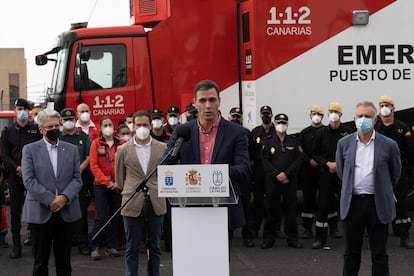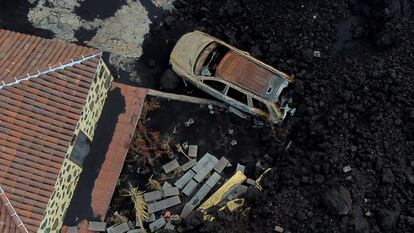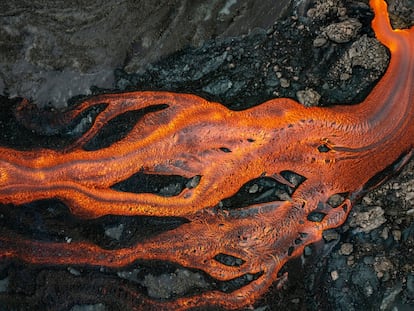After La Palma eruption ends, locals count the cost – and demand more help
Those who lost their properties or businesses to the lava spewed out by the new volcano are growing impatient over the lack of financial support

“The job of rebuilding and relaunching the island is beginning.” Those were the words of Spanish Prime Minister Pedro Sánchez on Monday, who was speaking from La Palma to announce that €138 million of aid has arrived in the wake of the recent volcanic eruption on the Canary Island. The task that lies ahead is greater in size than the nearly 150 million cubic meters of lava that the volcano spewed out over 85 days and eight hours, and which was officially declared to have ended on Christmas Day.
Sánchez appeared on Monday accompanied by his Socialist Party (PSOE) colleague, regional premier Ángel Víctor Torres, and with the leader of the island council, Mariano Hernández Zapata of the conservative Popular Party (PP). Also present were representatives of the security forces and civil protection who have been working to manage the eruption, which began on September 19. The prime minister greeted and thanked them all, after an event organized in the municipality of El Paso, and which was designed to represent a turning point for the fortunes of the island.
The lava from the eruption has created two deltas in the sea, one measuring 43 hectares and another further north of five hectares. The majority of the molten rock that was expelled, however, has destroyed years of work by the local residents. What’s more, the island has been practically cut into two.
The lava has buried 73.8 kilometers of roads, most significantly those that joined the west and the south of the island. By September 20, the lava had already buried a section of the LP-2, near El Paraíso. It was an unfinished route that connected El Paso with the south of La Palma. From one day to the next, what used to be 15-minute journeys were taking two hours and involved a number of changes when traveling by bus.
The situation worsened when other secondary routes such as the LP-213 were lost. This road linked Todoque – a locality that was completely buried by the eruption – and Puerto Naos. “It will take time to get these routes back,” explained recently Rubén Fernández, the technical head of Pevolca, the team of experts that has been monitoring the phenomenon. “To start with, we need to wait for the lava to cool. We will have to be patient.”

The island’s economy has also been affected. Banana crops account for €180 million of a total GDP of €1.58 billion (data from 2018), according to figures supplied by the regional government. A total of 228.7 hectares of banana plantations have been lost to the eruption, of a total of 370.1 of agricultural land that includes vineyards and avocado trees. “They either help us or we should just go home,” said last week Juan Carlos González in a café in the municipality of Tazacorte. “There are a lot of us who have ended up without a means to live.”
The lava has also buried key parts of the locals’ lives. Las Manchas cemetery, for example, was lost to the molten rock on November 25. As was La Laguna elementary school, at which 160 students studied. “I have started to pressure the education department so that they find a solution,” explains the principal, Mónica Viña, speaking by telephone. For now the students have been distributed between two other schools in Los Llanos de Aridane.
While the locals on the island have shown resilience and patience during the eruption, they are now starting to get impatient. Mónica Viña, like hundreds of other locals, was planning on attending a demonstration in Los Llanos de Aridane on Monday to demand that more assistance be delivered as soon as possible. “I know a lot of families who have not received anything at all,” she explains. The major emergency is related to housing. As many as 1,676 properties have been destroyed, according to records. Of these, 1,345 were residential.
“We understand the situation and we want to say to palmeros that we are going to continue to make an effort to comply with their requests,” said the head of the island council, Mariano Hernández Zapata, about these demands.
“We are still without plans, without them listening to us,” complained on Monday Juan Morín, the spokesperson for the first platform for victims of the eruption. The demonstrators are calling on the island council and Los Llanos de Aridane council to distribute donations, which are still being retained. “The situation that we are living through cannot go on much longer,” he adds. “The charity of the inhabitants of our land has no limits, but our mental health does.”
The mental health of locals on La Palma is, in fact, one of the major challenges facing the authorities. As the healthcare director on La Palma, Kilian Sánchez, said recently, “the true mental health problem is still to come.” The primary healthcare system has increased the number of appointments available and has been prescribing more antidepressants. “If we are unable to offer a response and let these problems become chronic, we could have a long-term problem.”
The volcano is no longer erupting, but its destructive power pervades among the inhabitants of La Palma.
The aid, in figures
The regional premier of the Canary Islands, Ángel Víctor Torres, is aware that the patience of La Palma residents is wearing thin. Perhaps for this reason he made an effort to stress the aid that has already arrived on the island. According to his figures, “more than €112 million” has been assigned to helping locals: more than €2 million for accommodation in hotels and the purchase of homes; more than €7 million in prefabricated houses; €264,000 for furniture and other items; and €4.13 for basic essentials. For the economic sectors affected, €29 million has been assigned.
Torres also announced that in “just a few days” an office will be opened to attend to citizens, at a cost of €300,000. “We had to set up these installations with no furniture nor internet connection,” he explains. “But it was supplied with resources and stuff as quickly as possible.”
According to the latest data, around 4,000 requests for assistance have been filed with this office, “and to date nearly 60% have been processed,” Torres claimed.
Tu suscripción se está usando en otro dispositivo
¿Quieres añadir otro usuario a tu suscripción?
Si continúas leyendo en este dispositivo, no se podrá leer en el otro.
FlechaTu suscripción se está usando en otro dispositivo y solo puedes acceder a EL PAÍS desde un dispositivo a la vez.
Si quieres compartir tu cuenta, cambia tu suscripción a la modalidad Premium, así podrás añadir otro usuario. Cada uno accederá con su propia cuenta de email, lo que os permitirá personalizar vuestra experiencia en EL PAÍS.
¿Tienes una suscripción de empresa? Accede aquí para contratar más cuentas.
En el caso de no saber quién está usando tu cuenta, te recomendamos cambiar tu contraseña aquí.
Si decides continuar compartiendo tu cuenta, este mensaje se mostrará en tu dispositivo y en el de la otra persona que está usando tu cuenta de forma indefinida, afectando a tu experiencia de lectura. Puedes consultar aquí los términos y condiciones de la suscripción digital.
More information
Últimas noticias
Most viewed
- Sinaloa Cartel war is taking its toll on Los Chapitos
- Oona Chaplin: ‘I told James Cameron that I was living in a treehouse and starting a permaculture project with a friend’
- Reinhard Genzel, Nobel laureate in physics: ‘One-minute videos will never give you the truth’
- Why the price of coffee has skyrocketed: from Brazilian plantations to specialty coffee houses
- Silver prices are going crazy: This is what’s fueling the rally











































